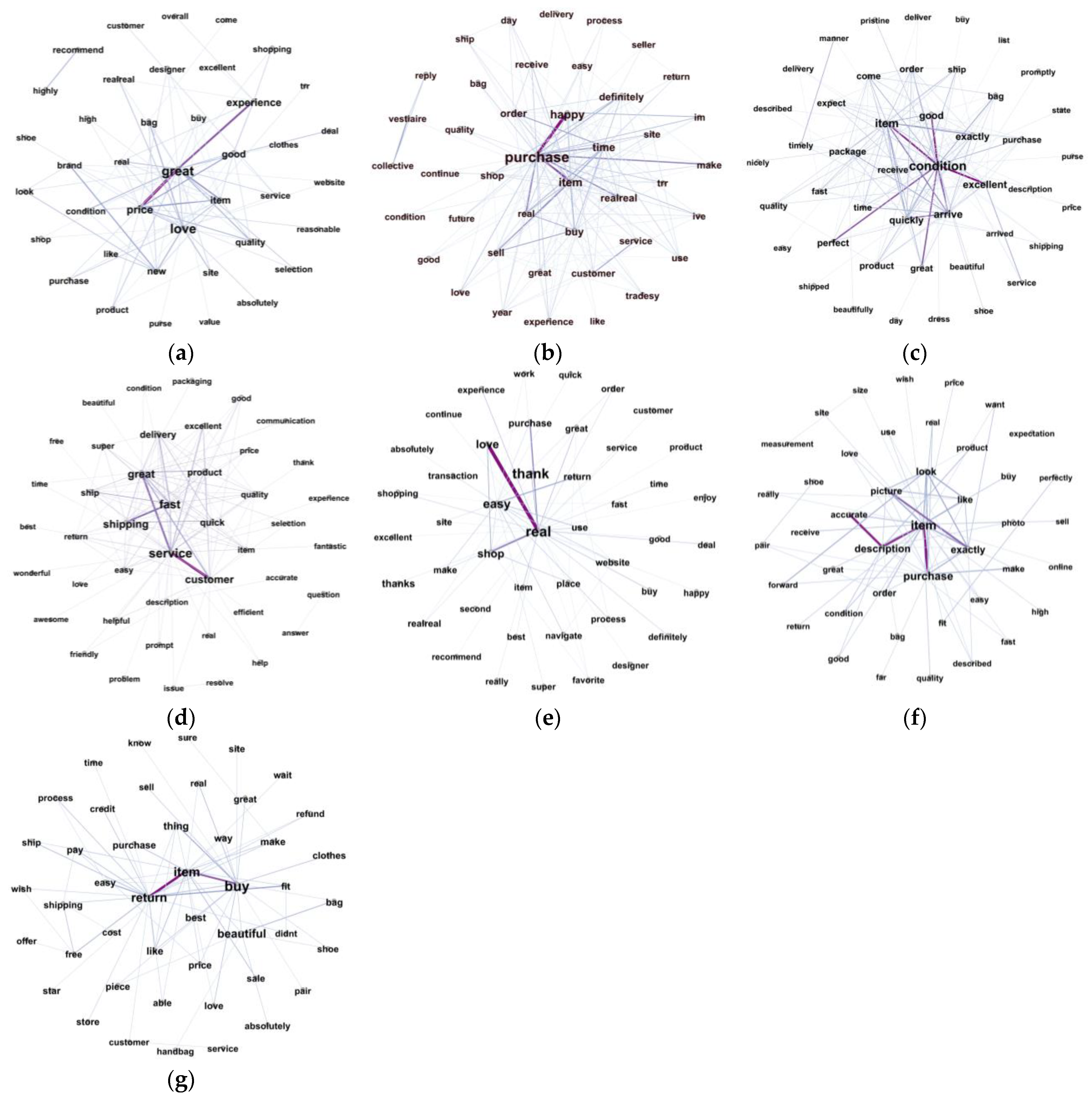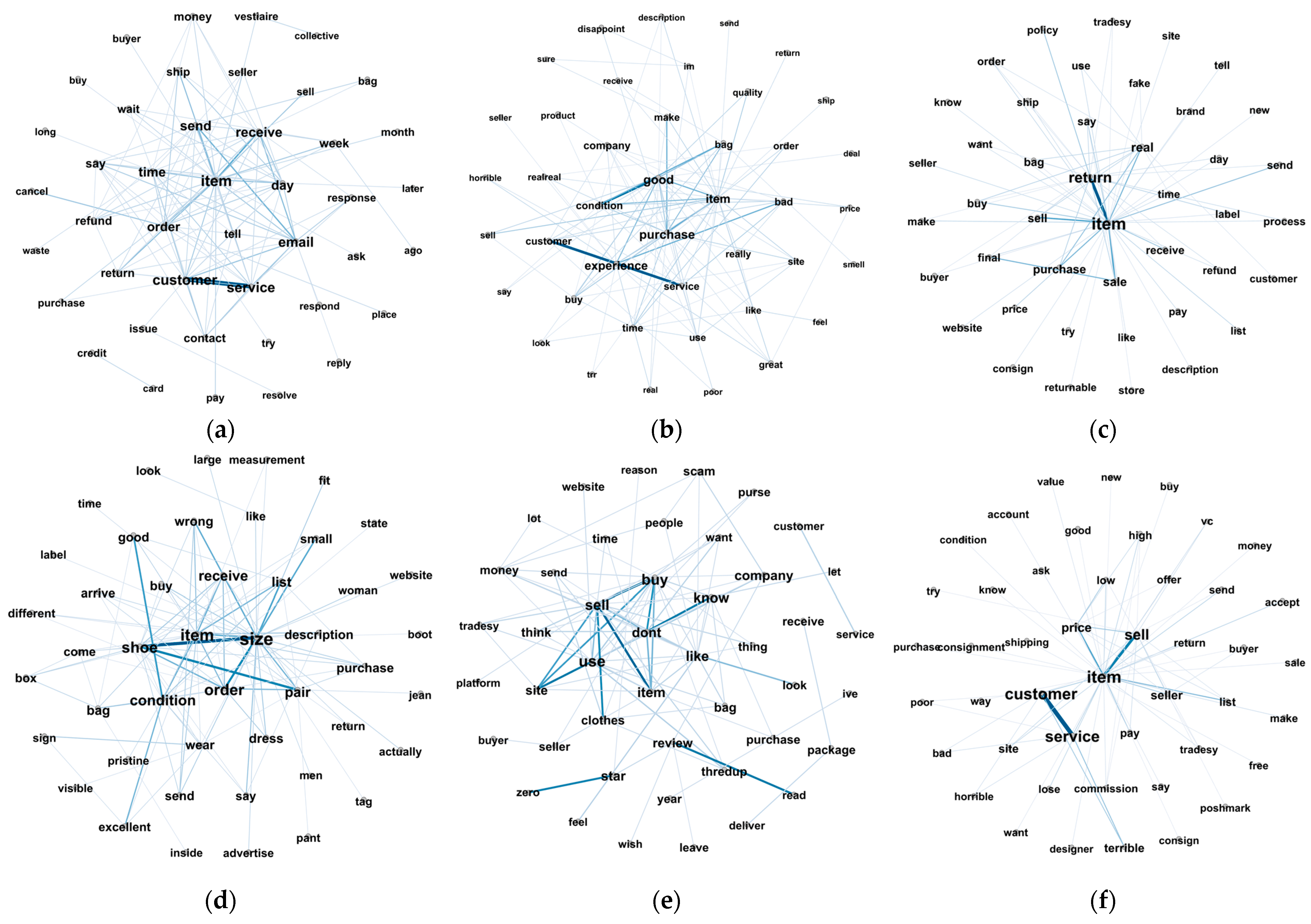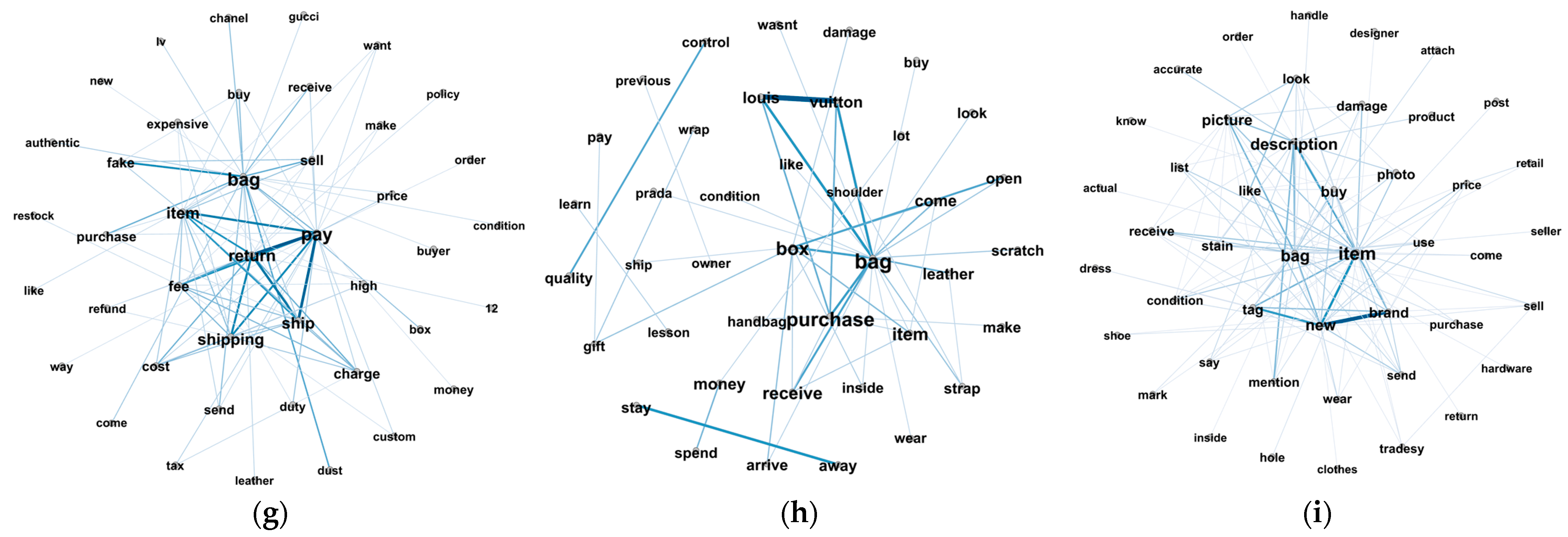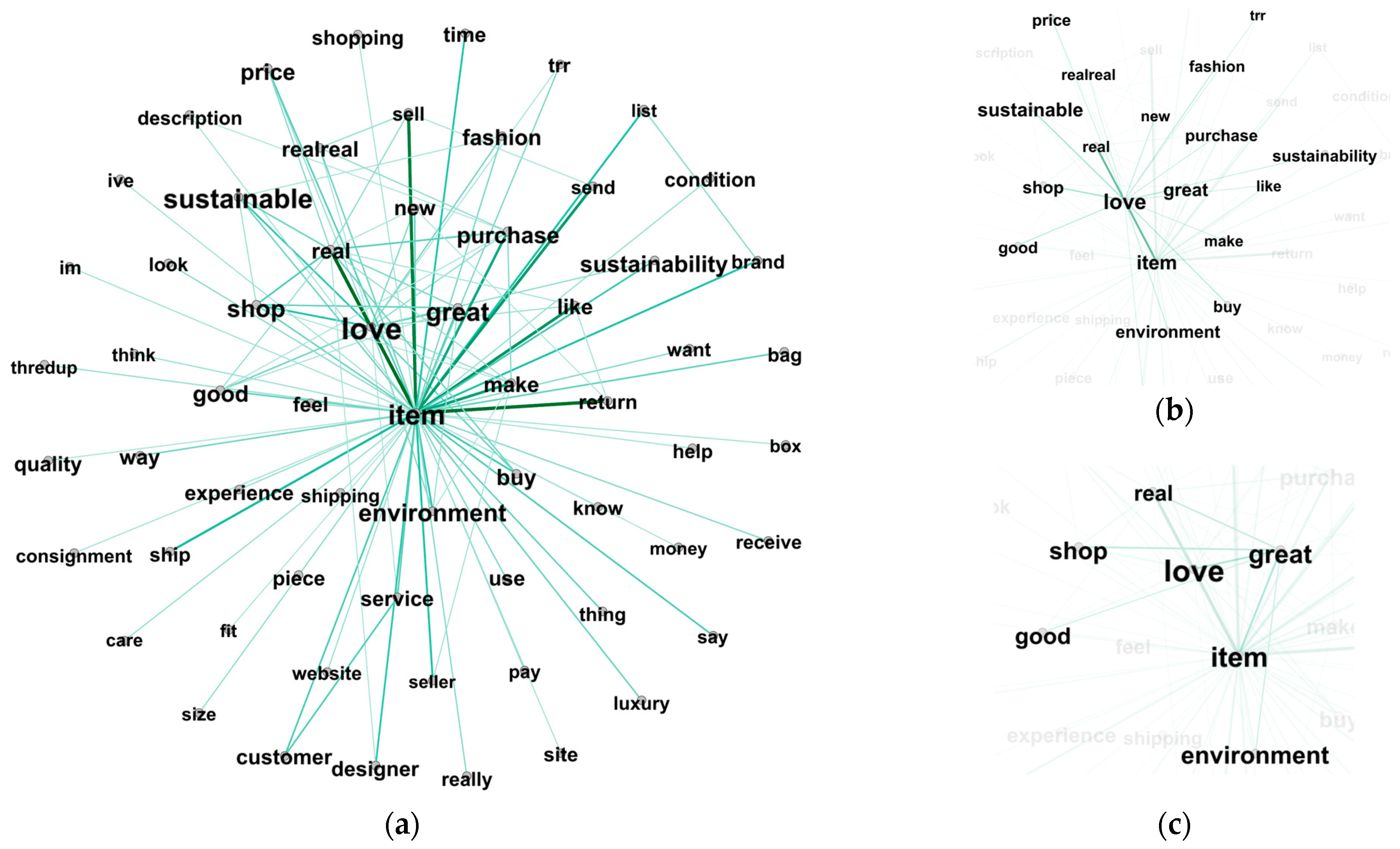Online Luxury Resale Platforms and Customer Experiences: A Text Mining Analysis of Online Reviews
Abstract
:1. Introduction
2. Literature Review
2.1. Fast Fashion and Environmental Concerns
2.2. Circular Fashion and Collaborative Consumption
2.3. Resale as a Format of Collaborative Consumption
2.4. Luxury Resale and Online Platforms
2.5. Consumer Experiences with Online Luxury Resale Platforms and Research Questions
- (1)
- How do online luxury resale platforms provide customer value to buyers and sellers? What are the driving values for consumers to buy or sell pre-owned products?
- (2)
- Are there any issues regarding buying and selling pre-owned products using online luxury resale platforms?
- (3)
- Does sustainability play a role in individuals’ consumption using online luxury resale platforms?
3. Methodology
3.1. Data Collection
3.2. Data Analysis
4. Findings and Discussions
4.1. LDA Analysis Results

| Themes | Associated Words | Sentence Percentage | Theme Label |
|---|---|---|---|
| 1 | back, get, customer, email, service, send, receive, still, order, item | 25.96% | Poor customer service (to both sellers and buyers) |
| 2 | good, purchase, experience, condition, first, company, item, bad | 23.08% | Bad (first) experience |
| 3 | real, item, return, sale, purchase, final, receive | 10.19% | Unfriendly return policy |
| 4 | size, shoe, order, item, condition, pair, list, receive, wrong, describe | 8.80% | Wrong sizing information or product in wrong sizes |
| 5 | would, never, purse, give, don’t, use, like, buy, know, need, time, question, year, work, many, people, take, trust | 9.43% | Untrustworthy service and product |
| 6 | item, customer, service, sell, price, even, get, terrible, would, anyone | 6.80% | Unsatisfactory services to sellers |
| 7 | bag, pay, shipping, ship, return, charge, fake, cost, fee, item | 5.80% | Financial risk/Hidden cost |
| 8 | purchase, bag, box, one, wasn’t, receive, purse, money, reduce, however | 5.19% | Flawed or fake item |
| 9 | description, picture, item, new, photo, bag, hole, brand, show, buy | 4.77% | Misleading or missing product information |


4.1.1. Themes Identified from Positive Reviews
4.1.2. Themes Identified from Negative Reviews
4.2. Results of Dictionary-Based Search
5. Results, Conclusions, and Discussion
Author Contributions
Funding
Institutional Review Board Statement
Informed Consent Statement
Data Availability Statement
Acknowledgments
Conflicts of Interest
References
- Reichart, E.; Drew, D. By the Numbers: The Economic, Social and Environmental Impacts of “Fast Fashion”; World Resources Institute: Washington, DC, USA, 2019. [Google Scholar]
- Sanghi, K.; Bharadwaj, A.; Taylor, L.; Turquier, L.; Zaveri, I. Consumers Are the Key to Taking Green Mainstream. Available online: https://www.bcg.com/publications/2022/consumers-are-the-key-to-taking-sustainable-products-mainstream (accessed on 15 December 2022).
- Abtan, O.; Ducasse, P.; Finet, L.; Gardet, C.; Gasc, M.; Salaire, S. Why Luxury Brands Should Celebrate the Preowned Boom; BCG: Boston, MA, USA, 2019; Available online: https://www.bcg.com/publications/2019/luxury-brands-should-celebrate-preowned-boom.aspx (accessed on 15 December 2022).
- D’Arpizio, C.; Levato, F. Lens on the Worldwide Luxury Consumer; Bain Company: Boston, MA, USA, 2014. [Google Scholar]
- Turunen, L.L.M.; Pöyry, E. Shopping with the resale value in mind: A study on second-hand luxury consumers. Int. J. Consum. Stud. 2019, 43, 549–556. [Google Scholar] [CrossRef]
- Duffy, K. Luxury Resale: A Circular Strategy by Vestiaire Collective; Bloomsbury: London, UK, 2021. [Google Scholar]
- Research and Markets Adds Report: Global Luxury Resale Market, Entertainment Close-up, 27 May 2022, p. NA. Gale In Context: Biography. Available online: link.gale.com/apps/doc/A705081606/BIC?u=lln_alsu&sid=bookmark-BIC&xid=074c6a05 (accessed on 9 December 2022).
- Berg, A.; Berjaoui, B.; Iwatani, N.; Zerbi, S. Welcome to Luxury Fashion Resale: Discerning Customers Beckon to Brands; McKinsey & Company: Atlanta, GA, USA, 2022; Volume 14, p. 2022. [Google Scholar]
- Chen, C. Can Fashion Resale Ever Be a Profitable Business? The Business of Fashion: London, UK, 2022. [Google Scholar]
- Dottle, R.; Gu, J. The Global Glut of Clothing Is An Environmental Crisis Bloomberg. 2022. Available online: https://www.bloomberg.com/graphics/2022-fashion-industry (accessed on 15 December 2022).
- Niinimäki, K.; Peters, G.; Dahlbo, H.; Perry, P.; Rissanen, T.; Gwilt, A. The environmental price of fast fashion. Nat. Rev. Earth Environ. 2020, 1, 189–200. [Google Scholar] [CrossRef]
- Remy, N.; Speelman, E.; Swartz, S. Style That’s Sustainable: A New Fast-Fashion Formula; McKinsey Global Institute: Paris, France; Amsterdam, The Netherlands; Southern California, CA, USA, 2016. [Google Scholar]
- Fletcher, K. Slow fashion: An invitation for systems change. Fash. Pract. 2010, 2, 259–265. [Google Scholar] [CrossRef]
- Bédat, M. Our Love of Cheap Clothing Has a Hidden Cost—It’s Time for a Fashion Revolution. 2016. Available online: https://medium.com/@zady/our-love-of-cheap-clothing-has-a-hidden-cost-its-time-for-a-fashion-revolution-fcf017cdbc6f (accessed on 9 December 2022).
- Dabija, D.-C.; Bejan, B.M.; Dinu, V. How sustainability oriented is Generation Z in retail? A literature review. Transform. Bus. Econ. 2019, 18, 140–155. [Google Scholar]
- Jain, S.; Hagenbeek, O.; Shogren, B. Global Sustainability Study: What Role Do Consumers Play in a Sustainable Future; SIMON-Kucher & Partners: Bonn, Germany, 2021. [Google Scholar]
- Yamane, T.; Kaneko, S. Is the younger generation a driving force toward achieving the sustainable development goals? Survey experiments. J. Clean. Prod. 2021, 292, 125932. [Google Scholar] [CrossRef]
- Kim, I.; Jung, H.J.; Lee, Y. Consumers’ value and risk perceptions of circular fashion: Comparison between secondhand, upcycled, and recycled clothing. Sustainability 2021, 13, 1208. [Google Scholar] [CrossRef]
- Iran, S.; Schrader, U. Collaborative fashion consumption and its environmental effects. J. Fash. Mark. Manag. Int. J. 2017, 21, 468–482. [Google Scholar] [CrossRef]
- Kathan, W.; Matzler, K.; Veider, V. The sharing economy: Your business model’s friend or foe? Bus. Horiz. 2016, 59, 663–672. [Google Scholar] [CrossRef]
- Joyner Armstrong, C.M.; Park, H. Sustainability and collaborative apparel consumption: Putting the digital ‘sharing’ economy under the microscope. Int. J. Fash. Des. Technol. Educ. 2017, 10, 276–286. [Google Scholar] [CrossRef]
- Perlacia, A.S.; Duml, V.; Saebi, T. Collaborative Consumption: Live Fashion, Don’t Own It. Beta 2017, 31, 6–24. [Google Scholar] [CrossRef]
- Balck, B.; Cracau, D. Empirical Analysis of Customer Motives in the Shareconomy: A Cross-Sectoral Comparison; Working Paper Series; Faculty of Economics and Management: Magdeburg, Germany, 2015. [Google Scholar]
- Arribas-Ibar, M.; Nylund, P.A.; Brem, A. Circular business models in the luxury fashion industry: Toward an ecosystemic dominant design? Curr. Opin. Green Sustain. Chem. 2022, 37, 100673. [Google Scholar] [CrossRef]
- Armstrong, C.M.; Niinimäki, K.; Kujala, S.; Karell, E.; Lang, C. Sustainable product-service systems for clothing: Exploring consumer perceptions of consumption alternatives in Finland. J. Clean. Prod. 2015, 97, 30–39. [Google Scholar] [CrossRef]
- Botsman, R.; Rogers, R. What’s Mine Is Yours; Harper Business: New York, NY, USA, 2010; Volume 1. [Google Scholar]
- Erdly, C. Resale Set to Be Star of Retail in 2022 for Consumers and Brands; Forbes: Jersey City, NJ, USA, 2022. [Google Scholar]
- Pellissier, C. Second-Hand: 33 Million New Customers in 2020 in the United States Alone. Available online: https://sg.style.yahoo.com/second-hand-33-million-customers-092438320.html (accessed on 5 January 2023).
- ResearchAndMarkets.com. Global Luxury Resale Market Growth Forecasts to 2026: A US $51.77 Billion Market by 2026. Available online: https://www.businesswire.com/news/home/20220523005721/en/Global-Luxury-Resale-Market-Growth-Forecasts-to-2026-A-US51.77-Billion-Market-by-2026---ResearchAndMarkets.com (accessed on 6 January 2023).
- ThredUp Inc. 2022 Fashion Resale Market and Trend Report; ThredUp Inc.: Cambridge, MA, USA, 2022. [Google Scholar]
- Bianchi, F.; Flicker, I.; Krueger, F.; Ricci, G.; Schuler, M.; Seara, J.; Willersdorf, S. The Secondhand Opportunity in Hard Luxury. Available online: https://www.bcg.com/publications/2020/secondhand-opportunity-hard-luxury (accessed on 15 October 2022).
- McKinsey & Company. Is Luxury Resale the Future of Fashion; McKinsey & Company: Atlanta, GA, USA, 2020. [Google Scholar]
- Machado, M.A.D.; de Almeida, S.O.; Bollick, L.C.; Bragagnolo, G. Second-hand fashion market: Consumer role in circular economy. J. Fash. Mark. Manag. Int. J. 2019, 3, 382–395. [Google Scholar] [CrossRef]
- Lou, X.; Chi, T.; Janke, J.; Desch, G. How Do Perceived Value and Risk Affect Purchase Intention toward Second-Hand Luxury Goods? An Empirical Study of US Consumers. Sustainability 2022, 14, 11730. [Google Scholar] [CrossRef]
- Guzzetti, A.; Crespi, R.; Belvedere, V. “Please don’t buy!”: Consumers attitude to alternative luxury consumption. Strateg. Chang. 2021, 30, 67–78. [Google Scholar] [CrossRef]
- Turunen, L.L.M.; Leipämaa-Leskinen, H. Pre-loved luxury: Identifying the meanings of second-hand luxury possessions. J. Prod. Brand Manag. 2015, 24, 57–65. [Google Scholar] [CrossRef]
- Cervellon, M.-C.; Vigreux, E. Narrative and emotional accounts of secondhand luxury purchases along the customer journey. In Vintage Luxury Fashion; Springer: Berlin/Heidelberg, Germany, 2018; pp. 79–95. [Google Scholar]
- Deloitte Ireland. Consumer Review Online: A Minimum Requirment or a Competitive Advantage? Deloitte: London, UK, 2015. [Google Scholar]
- Turunen, L.L.M. Luxury Resale Shaping the Future of Fashion. In The Future of Luxury Brands; De Gruyter: Berlin, Germany, 2022; pp. 185–202. [Google Scholar]
- Bird, S.; Klein, E.; Loper, E. Natural Language Processing with Python: Analyzing Text with the Natural Language Toolkit; O’Reilly Media, Inc.: Sebastopol, CA, USA, 2009. [Google Scholar]
- Blei, D.M.; Ng, A.Y.; Jordan, M.I. Latent dirichlet allocation. J. Mach. Learn. Res. 2003, 3, 993–1022. [Google Scholar]
- Lang, C.; Xia, S.; Liu, C. Style and fit customization: A web content mining approach to evaluate online mass customization experiences. J. Fash. Mark. Manag. Int. J. 2021, 25, 224–241. [Google Scholar] [CrossRef]
- Manikonda, L.; Venkatesan, R.; Kambhampati, S.; Li, B. Evolution of fashion brands on Twitter and Instagram. arXiv 2015, arXiv:1512.01174. [Google Scholar]
- Minami, A.L.; Ramos, C.; Bortoluzzo, A.B. Sharing economy versus collaborative consumption: What drives consumers in the new forms of exchange? J. Bus. Res. 2021, 128, 124–137. [Google Scholar] [CrossRef]
- Nappi, E. The Rise of the Luxury Resale Market: A New Frontier or a Potential Threat for Luxury Brands and the Luxury Industry? Master’s Thesis, LUISS Guido Carli, Rome, Italy, 2021. [Google Scholar]
- Armstrong, C.M.J.; Park, H. Online clothing resale: A practice theory approach to evaluate sustainable consumption gains. J. Sustain. Res. 2020, 2, e200017. [Google Scholar]
- Wichmann, J.R.; Wiegand, N.; Reinartz, W.J. The platformization of brands. J. Mark. 2022, 86, 109–131. [Google Scholar] [CrossRef]
- Rudawska, E.; Grębosz-Krawczyk, M.; Ryding, D. Sources of Value for Luxury Secondhand and Vintage Fashion Customers in Poland—From the Perspective of Its Demographic Characteristics. In Vintage Luxury Fashion; Springer: Berlin/Heidelberg, Germany, 2018; pp. 111–132. [Google Scholar]

| Platform | Review Website | Review Count | Avg. Rating (Out of 5) |
|---|---|---|---|
| The RealReal | https://www.trustpilot.com/review/therealreal.com | 39,419 | 4.02 |
| ThredUp | https://www.trustpilot.com/review/thredup.com | 2406 | 3.01 |
| Tradesy | https://www.trustpilot.com/review/tradesy.com | 3598 | 3.72 |
| Vestiaire Collective | https://www.trustpilot.com/review/vestiairecollective.com | 6211 | 3.04 |
| Data Set | Review Count | Sentence Count | Percentage | Sentence Count/Review | Avg. Customer Rating (Out of 5) |
|---|---|---|---|---|---|
| Positive | 35,336 | 86,099 | 56.63% | 2.44 | 4.86 |
| Negative | 16,298 | 65,935 | 43.37% | 4.05 | 1.50 |
| Overall | 51,634 | 152,034 | 100% | 2.94 | 3.84 |
| Themes | Associated Words | Sentence Percentage | Theme Label |
|---|---|---|---|
| 1 | love, great, price, experience, new, good, bag, item, quality, brand | 29.70% | Great value/Real deal |
| 2 | purchase, happy, time, first, definitely, realreal, item, process, day, awesome, work | 19.35% | Pre-loved treasure |
| 3 | condition, describe, excellent, item, arrive, good, quickly, perfect, package, exactly | 15.15% | Good product condition and delivery |
| 4 | service, fast, shipping, great, customer, delivery, quick, ship, product, super | 10.51% | Great customer service |
| 5 | real, easy, thank, shop, thanks, love, place, transaction, return | 6.38% | Ease of use |
| 6 | exactly, purchase, item, picture, please, look, describe, description, accurate, find | 10.40% | Trustworthy product information |
| 7 | buy, beautiful, return, item, would, thing, wait, keep, give | 5.04% | Reasonable return policy |
Disclaimer/Publisher’s Note: The statements, opinions and data contained in all publications are solely those of the individual author(s) and contributor(s) and not of MDPI and/or the editor(s). MDPI and/or the editor(s) disclaim responsibility for any injury to people or property resulting from any ideas, methods, instructions or products referred to in the content. |
© 2023 by the authors. Licensee MDPI, Basel, Switzerland. This article is an open access article distributed under the terms and conditions of the Creative Commons Attribution (CC BY) license (https://creativecommons.org/licenses/by/4.0/).
Share and Cite
Liu, C.; Xia, S.; Lang, C. Online Luxury Resale Platforms and Customer Experiences: A Text Mining Analysis of Online Reviews. Sustainability 2023, 15, 8137. https://doi.org/10.3390/su15108137
Liu C, Xia S, Lang C. Online Luxury Resale Platforms and Customer Experiences: A Text Mining Analysis of Online Reviews. Sustainability. 2023; 15(10):8137. https://doi.org/10.3390/su15108137
Chicago/Turabian StyleLiu, Chuanlan, Sibei Xia, and Chunmin Lang. 2023. "Online Luxury Resale Platforms and Customer Experiences: A Text Mining Analysis of Online Reviews" Sustainability 15, no. 10: 8137. https://doi.org/10.3390/su15108137






